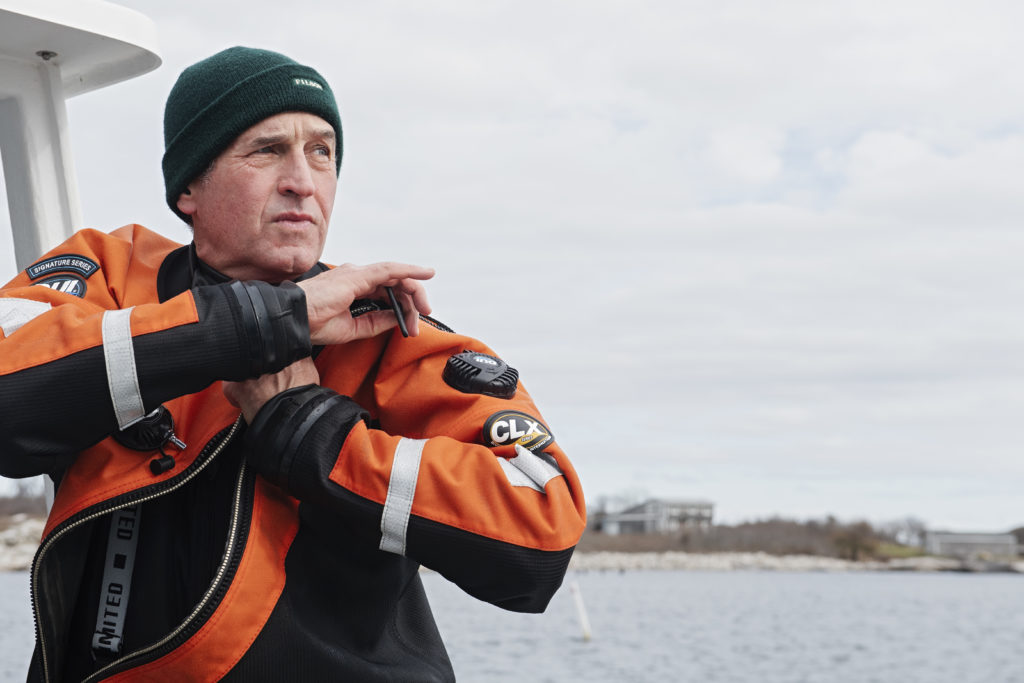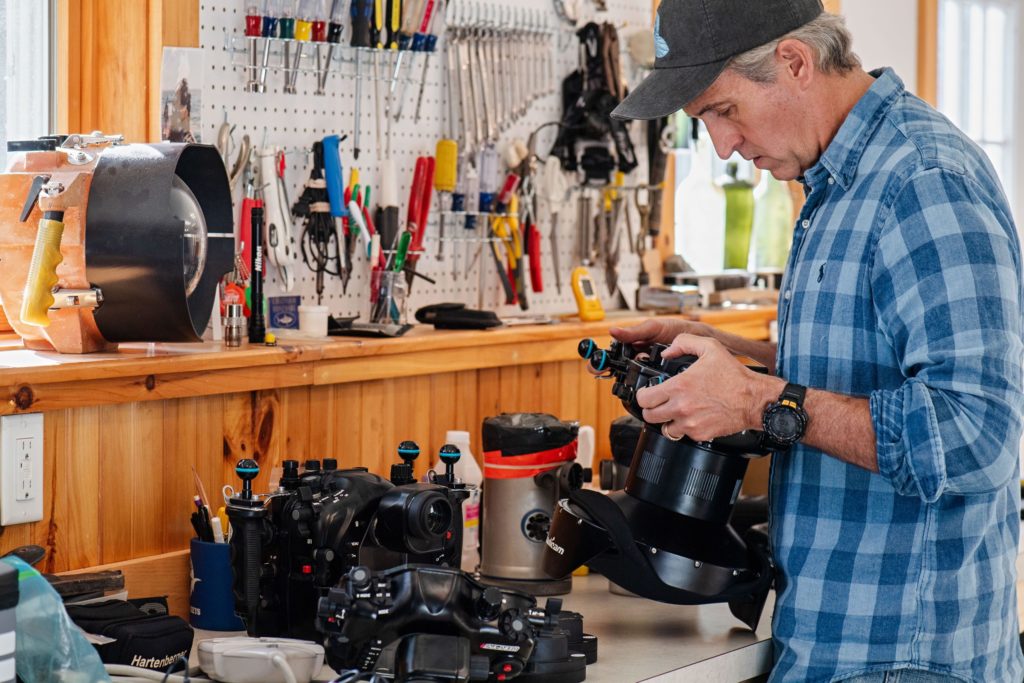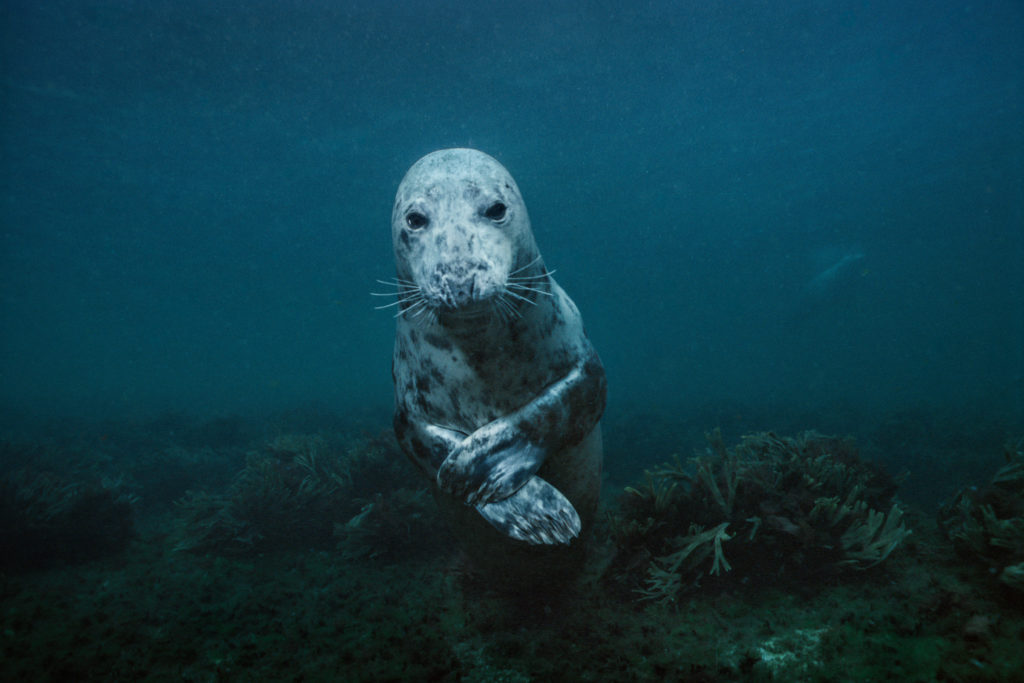The Maine Man Capturing the World’s Oceans

The Maine Man Capturing the World’s Oceans
National Geographic photographer Brian Skerry’s home may be in York, but he lives his life under the sea.
By Anna Fiorentino
Photography by Nicole Wolf
Issue: May 2021
There must have been 50 of them, staring straight at us like they expected a treat— their slippery, barrel-shaped bodies beaching on the rocks and playfully bobbing up and down on the choppy saltwater. “You can identify seals by the shape of their heads. The harbor seal’s is smaller and looks more like a dog,” says Brian Skerry. “The grey seal’s looks more like a horse.” He would know. Skerry has spent a good chunk of his adult life on or under the water, photographing aquatic animals. Short of having gills, he belongs in the ocean.
We’re off the Isles of Shoals, a world-famous site for diving with seals, on the border of Maine and New Hampshire and six miles from the mainland. Since 2017 Skerry and his wife, Marcia, and their two daughters have lived not far from here, in York. It’s the first time in decades an assignment hasn’t put him on a plane, and coincidentally, this one was approved just months before the pandemic. For his 29th story for National Geographic, the internationally acclaimed photographer is zooming in on the Gulf of Maine, a biodiverse body of water from Cape Cod to Nova Scotia that for the past 30 years has warmed faster than 99 percent of the world’s oceans, according to the Gulf of Maine Research Institute. “Maine is the epicenter of oceanic climate change,” says Skerry.

It’s mid-November, and the wind is picking up. The 48-degree air cuts through my base layer, and I’m shivering just watching Skerry zip up his drysuit. But Skerry, who’s chatty and poised, and in moments the very image of Paul Newman, reminds me that the recorded sea temperatures in the past few years are milder than they’ve ever been—the balmiest being last August. The Gulf of Maine, which has been warming seven times faster than the rest of the planet for the past 15 years, is one of the most nutrient-rich bodies of water in the world. The cold Labrador Current from northern Canada and the warm Gulf Stream meet offshore upwellings to draw up nitrogen and phosphate from a mix of sediment on the ocean floor that dates back 2.6 million years, to the retreat of Laurentide Ice Sheet. “It circulates in a counterclockwise fashion to create a proliferation of life,” says Skerry, by now fluent in the poetry of the ocean.
Strapped into his air tank, Skerry steadies himself on the gunwale and falls back. His assistant, Steve De Neef, who lives in South Berwick and is from Belgium, plunges in after him. Treading water, Skerry reaches up for an unwieldy waterproof casing that suspends his Nikon D5 between two gigantic strobes. With all 100 pounds of gear, he sinks 52 feet down into the darkness, leaving behind a trail of bubbles.


Skerry and De Neef before diving below to observe the effects of climate change in the Gulf of Maine. 
Over 42 years of navigating the planet’s uncharted waters, Skerry says he sees nothing but degradation, down to the plankton and krill at the base of the food chain. The native fish Skerry photographed in the Gulf of Maine in the 1980s are harder to spot, new invasive species are arriving from the south, and models indicate that in 30 to 40 years lobster could be on the decline in southern Maine. Greenhouse gases continue to trap heat in the air and ocean, and there’s no place in the Gulf of Maine that’s fully protected from human activities, he says. That’s why he pitched a two-year story, set to run in 2022, to National Geographic. By now a sort of sea-life anthropologist, Skerry knows what tiger shark biologists don’t know about sperm whales, and what the squid scientists might not understand about tiger sharks. He says, “Everything on this planet, and in the universe and multiverse, works in harmony like the gears of a finely made Swiss watch. As we begin to remove the gears, it breaks down.” Reversing environmental damage and replenishing the fish supply means protecting the Earth’s surface—made up of 71 percent water—because “as goes nature, so goes us,” he says. Everything has its role, from humankind to the curious seals to Maine’s now-deadly sharks to our seabirds and, of course, Skerry’s favorite: the whales.


Blue sharks frequent the offshore waters in New England during summer months, feeding on fish. Taken by Brian Skerry. 
Cod and cunner fish in the Cashes Ledge, a rich region of marine biodiversity located approximately 90 miles off the coast in the Gulf of Maine. Taken by Brian Skerry
“If there was just one thing I could do for the rest of my life, it would probably be free diving with whales,” says Skerry, who just wrapped up a three-year assignment chronicling the challenges and triumphs of the massive mammals in the changing ocean at 24 locations, including the Canadian Arctic, the Azores, and the Falkland Islands. His images are set to run in May 2021 in National Geographic, as well as in a coffee table book and a four-part National Geographic Channel and Disney Plus documentary series called Secrets of the Whales, produced by James Cameron and narrated by Sigourney Weaver.
After an hour, Skerry pops back up, like one of the happy seals, to report seeing a single lobster, some moon snails, a baby flounder, and a hermit crab taking refuge in an abandoned seashell. He passes up his flippers. Things move slower underwater. They require patience.
Every time Skerry goes on an assignment somewhere in the world, he’s contending with weather. The visibility might be poor, and the animals might not be out, or they might not let him come close. His underwater camera housing can flood, boats can break down, and people can be unreliable. “You hire a boat captain, and he doesn’t show because he’s hung over,” Skerry says. “You have to navigate all of these problems and still come back with the goods.” We turn in early to beat the storm, and now, layered up snug in the aft with his coffee mug, Skerry quiets down like he often does after a dive, and looks back at the sea.


Becoming one of the best underwater photographers in the world—and the Rolex National Geographic Explorer of the Year for 2017—doesn’t happen overnight, or without major sacrifices and periods of self-doubt. Even after freelancing for decades for National Geographic and contributing to other magazines including Smithsonian, Audubon, Sports Illustrated, Esquire, and Men’s Journal, putting out 12 books, receiving countless prestigious awards, giving a TED Talk, and presenting to the United Nations and the World Economic Forum, Skerry still can’t let up. On the road to joining the board of trustees for the New England Aquarium and taking the first underwater images of a U.S. president—Barack Obama—you work every holiday, he says. “You have to constantly produce. There’s a long line of people waiting to take your job,” Skerry says. “If I had a nickel for every time somebody at National Geographic said, ‘We don’t publish excuses, Mr. Skerry. I don’t care if there was a hurricane, I don’t care if the boat sank, I don’t care if the sharks weren’t there. You either got it, or you didn’t get it.’ And that’s it.”
People don’t fully understand that the odds against making it in this business are astronomical, Skerry tells me, and as a freelancer myself, I understand more than most. “We do all the work to pitch everything, and the editors may not take the story. It’s not unlike becoming a professional athlete. You’re only as good as your last season,” he says.

Skerry entered the game at age 17 with a used 35-millimeter amphibious Nikonos underwater camera modeled after one invented by Jacques Cousteau, one of his two heroes. His parents, who worked in the textile mills in Uxbridge, Massachusetts, after his dad returned from World War II, never considered photography to be a real job, but they unknowingly precipitated their son’s dream to shoot for National Geographic by encouraging Skerry to get dive certified in 1978. “I attended my first Boston Sea Rovers dive conference, and I remember sitting in the audience as a teenager watching these filmmakers and photographers and scientists present their work,” recalls Skerry, who’s scheduled to be the master of ceremonies for this year’s conference. “I often describe it as an epiphany,” he says. “On the way home, I said to my girlfriend at the time—now my wife—I know what I want to be: an underwater photographer.”
He worked for free so he could dive for free; for ten years Skerry worked on a charter boat guiding divers out to shipwrecks off Rhode Island. His first published photo—of a shipwreck—ran in the Boston Globe in 1984, the year he graduated from Worcester State University. He forged ahead, freelancing for dive magazines and paying the bills selling cardboard boxes, until, while diving in the Bahamas, he came face to face with a ten-foot-long fish that had inspired sea serpent legends. It had the head of a demon and a flaming red mane, like something from the Cousteau documentaries he’d watched as a kid, and in that moment his dream became real. National Geographic published his photo, the first ever taken of a live oarfish, in its December 1999 issue. It prompted Skerry’s other hero, a Mainer at the time by the name of Bill Curtsinger, whom he’d met briefly at a diving show, to call and congratulate Skerry. Curtsinger was a cold-water diver known for his images of whales and scenes from under the ice sheet. The two hit it off and took a few dive trips together, and Curtsinger asked Skerry to relieve him of a National Geographic assignment: photographing a 1717 pirate shipwreck buried in the sand off Cape Cod.
“He told me ‘The visibility is terrible, and I just don’t think it’s worth my time to go back out there, but they’re going to send somebody, so I’ll recommend you if you want. But keep in mind that, with National Geographic, you’re only going to get one chance. If you blow it, they’re not going to call again, and with this story, I think you have a 98 percent chance of failure,’” Skerry remembers. But down he went into the curtain of weeds, where he found a way to illuminate the wreckage: with movie lights rather than his flash and slide film. The editors liked what they saw, and Skerry landed his first of two fellowships, in Cuba.
Three years later, in 2001, he found himself without power during a raging storm in an underwater lab and habitat the size of a school bus, parked on the ocean floor at Key Largo’s Aquarius Reef Base habitat, where NASA trains astronauts. “We were in this dim tungsten emergency lighting, and the air began to thicken,” recalls Skerry, who was there for a week to photograph scientists tagging marine wildlife. In a diver’s state of saturation—with nitrogen flowing through his veins and no time to decompress for a safe return to the surface—he remembered something the director of photography had told him before he left. “He said, ‘I know you’re gonna have a lot on your plate, Brian, but look for human dynamics; look for stress in people and see if you can capture some of that, as well as the wildlife,’” says Skerry. “I wasn’t really sure how until our lives were threatened, and I saw the look on people’s faces.”

It’s become his business to wait for these kinds of fleeting moments that you can’t swim fast enough to catch. No 600-millimeter lens can capture them. You gain a subject’s trust on their terms and let them come close, and there’s no better example of that than with Maine seals. “I was once in the water for four or five hours and grey seals were swimming all around me, inching closer until they began playfully chewing on my fins. One of them that had been building up the courage, snaked up in the kelp, rose up right next to me, and very properly folded his hands in front of his chest like he was saying ‘take my picture,’’’ recalls Skerry. He took the photo, one of his most famous, appearing in publications all over the world, in the waters off Acadia National Park. And years from now, long after his fieldwork for his latest story is complete, Skerry will still be recording sea life in the Gulf of Maine. “I’ve traveled to all seven continents— the polar regions and tropical coral reefs—but I love these temperate waters, and to come back and to live here is a dream come true,” he says. “I’m invested in the region and Maine waters until my dying day.”






